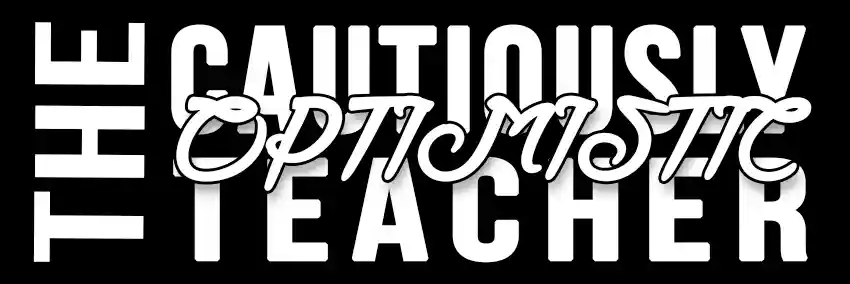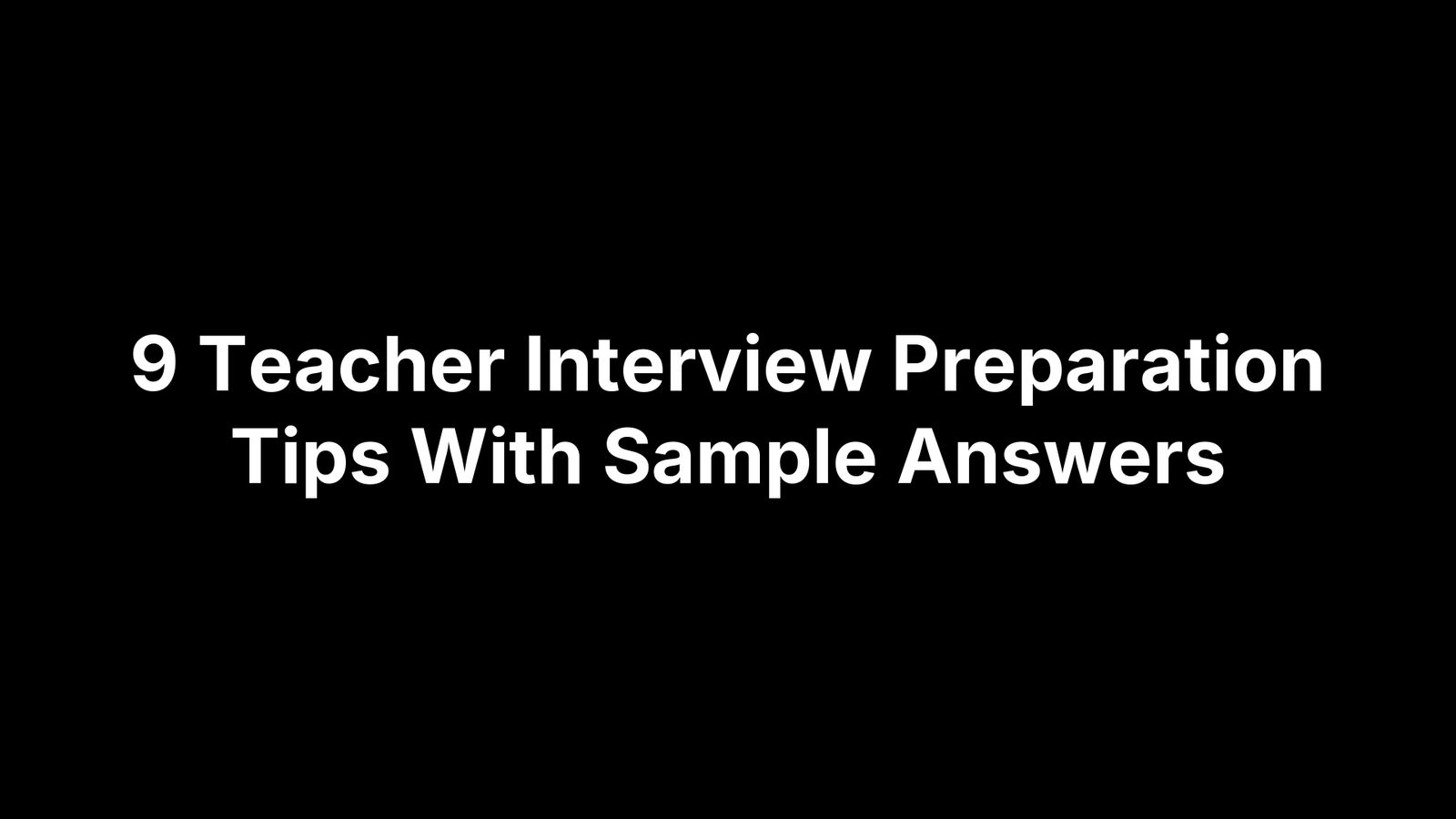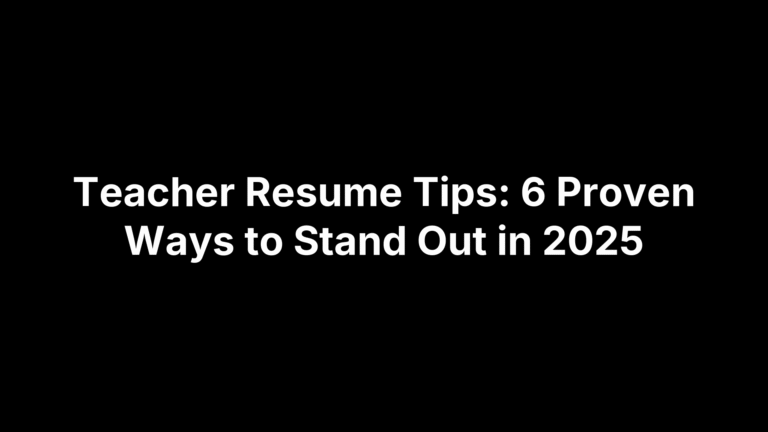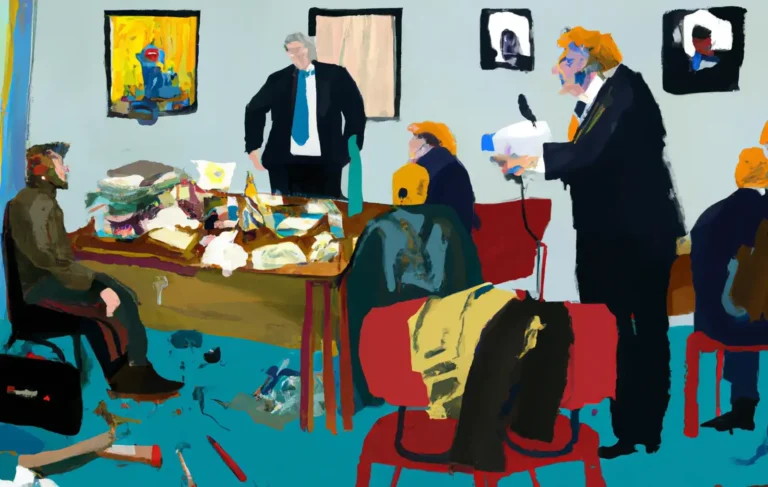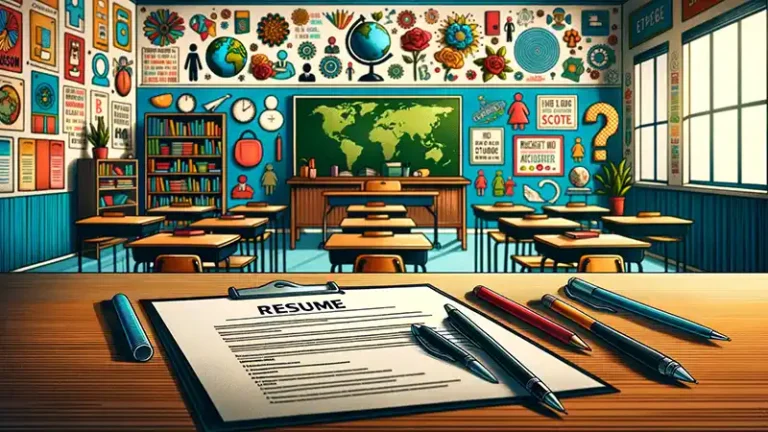9 Teacher Interview Preparation Tips With Sample Answers
The stakes feel huge: you know you’re a strong educator, but turning years of classroom wins into sharp, student-centered answers under bright lights is hard. Principals aren’t just checking credentials—they’re listening for proactive classroom management, real differentiation with data, literacy support for all learners, engagement and voice, thoughtful tech and PBL, authentic family partnerships, and a growth-minded professional who fits their mission. Get ready with these teacher interview preparation tips.
This guide hands you a plan. You’ll get nine field-tested preparation moves, each with three parts: what interviewers actually want to hear, how to prepare step by step, and a sample answer you can adapt. We’ll cover tailoring to a school and district, crafting a tight teaching philosophy and growth plan, telling restorative management stories, demonstrating data-informed differentiation, elevating engagement and student voice, integrating tech and collaborative PBL, partnering with families, and arriving with a polished portfolio and STAR-ready stories. We’ll also show quick ways to use The Cautiously Optimistic Teacher’s tools to fast‑track your prep. Ready to turn your practice into powerful interview stories? Let’s start with the fastest win.
1. Use The Cautiously Optimistic Teacher to fast-track your prep
If you’ve got limited time, use our tools to turn your practice into short, evidence-rich stories and clean artifacts you can show. This is teacher interview preparation that compresses hours into a focused sprint—so you walk in with aligned examples, not vague claims.
What interviewers want to hear
They want proof you plan proactively, teach for all learners, and reflect on results—aligned to their mission. Back that with a portfolio artifact and you instantly stand out.
- Clear outcomes: standards, data, and results.
- Proactive management: restorative, relationship-first moves.
- Student-centered learning: voice, tech/PBL, and family partnership.
How to prepare
Use The Cautiously Optimistic Teacher to build tight, showable evidence in under an hour.
- Align fast: Map the school’s mission to one of our unit snapshots; print a one-page overview.
- Differentiate smart: Use the Differentiated Instruction Helper to draft a tiered task from a recent assessment.
- Elevate rigor: Run the Question Generator for higher-order prompts; add a quick-check from the Worksheet Maker.
- Package + rehearse: Drop artifacts into a slim portfolio and practice three STAR stories (management, differentiation, engagement).
Sample answer you can adapt
“After a midpoint check showed three performance bands, my goal was to close gaps without slowing growth. I built a tiered task: a short reteach with manipulatives for emerging learners, a choice board with text sets for on-level, and a Socratic discussion with student-written questions for advanced. I used exit tickets to adjust groups the next day and called two families to coordinate supports. Most students moved up at least one band, and participation rose noticeably.”
2. Research the school and district so you can tailor every answer
The quickest way to level up your teacher interview preparation is to research the school and district and mirror their language, priorities, and practices. When you demonstrate you understand their mission, learners, and curriculum, your examples feel specific, credible, and memorable.
What interviewers want to hear
They want answers that sound like you already work there—aligned, informed, and student-centered.
- Mission alignment: You reference their vision and connect it to your practice.
- Community awareness: You understand student demographics and family engagement norms.
- Curriculum fluency: You know standards, assessments, and core initiatives.
- Consistent language: You use their terms (SEL, restorative, PBL, MTSS) accurately.
How to prepare
Scan a few high-yield sources, then script one alignment sentence for each core priority.
- Mission/vision: Pull 2–3 phrases you can echo in answers.
- District priorities: Note initiatives (literacy across content, SEL, tech integration).
- Curriculum/assessments: Identify key standards, benchmarks, and common rubrics.
- Learner profile: Note languages, programs (ELL, SPED), and community partners.
- Tech stack: Confirm LMS, device model, and commonly used classroom tools.
Sample answer you can adapt
“Your mission emphasizes equity, literacy across content, and strong school–family partnerships. In my recent nonfiction unit, I aligned tasks to district reading standards and used your common rubric for feedback. I built text sets that reflected our community languages, offered scaffolded note-catchers for multilingual learners, and hosted a brief family overview in English and Spanish so supports matched home routines. Using the LMS for weekly progress notes kept communication transparent. Exit tickets showed growth in citing evidence across groups, and family check-ins increased student follow-through the next week.”
3. Craft a compelling teaching philosophy and growth plan
Your teaching philosophy is the headline; your growth plan is the proof you live it. Strong teacher interview preparation turns beliefs into brief, concrete statements backed by outcomes and a clear plan to keep improving—without framing “weaknesses,” but by identifying where you’ll expand your efficacy next.
What interviewers want to hear
They’re listening for a concise, student-centered stance that translates to daily moves and measurable results.
- Clear, student-first belief: One or two sentences that center equity, literacy, and belonging.
- Practice, not platitudes: Specific routines (feedback cycles, differentiation, restorative moves).
- Evidence of impact: Data points, work samples, or observed outcomes.
- Growth mindset with focus: 1–2 SMART goals tied to school/district priorities (SEL, literacy, tech, MTSS).
- Alignment: Language and priorities that mirror their mission.
How to prepare
Draft a tight statement and pair it with a realistic, mission-aligned growth plan.
- Compress your philosophy:
Belief → Daily move → Student outcomein 40–50 words. - Pick two proofs: A brief data win and a qualitative climate/engagement win.
- Set two SMART goals (90 days): Tie them to district initiatives (e.g., literacy across content, restorative practices).
- Name supports: PLCs, mentoring, observations, and select PD you’ll leverage.
- Rehearse it together: Philosophy (50s) + evidence (60s) + growth plan (40s).
Sample answer you can adapt
“My philosophy: every student can hit grade-level targets when instruction is scaffolded, culturally responsive, and driven by timely feedback. In practice, that looks like tiered tasks, conferring cycles, and routine student reflection. In our argument unit, exit tickets and small-group workshops moved 72% of students up at least one rubric band on citing evidence, and classroom surveys showed a 25% jump in ‘I feel confident sharing my thinking.’
Looking ahead, I’m focused on two goals aligned to your literacy and restorative priorities. First, within 90 days I’ll implement a weekly evidence-citation routine in science and social studies and track proficiency growth on a common rubric. Second, I’ll strengthen restorative circles by co-planning norms with students and monitoring office referrals and belonging survey items. I’ll leverage our PLC, peer observations, and coaching to iterate quickly.”
4. Prepare proactive, restorative classroom management stories
Nothing calms interview nerves like a ready story that shows you prevent problems before they start and restore relationships when they do. In your teacher interview preparation, build narratives that center routines, relationships, and restorative practices—so you’re not just “handling” behavior, you’re cultivating a safe, inclusive community where learning can happen.
What interviewers want to hear
They’re listening for a plan-first mindset: proactive classroom management, trauma‑informed awareness, and restorative responses that keep students connected to learning. Show that you collaborate with families and support staff, and that you monitor impact.
- Proactive systems: Co-created norms, predictable routines, and clear practice of procedures.
- De-escalation: Quiet cues, calm corners, check-ins, and choice language.
- Restorative moves: Circles, brief conferences, and logical—not punitive—consequences.
- Equity lens: Strategies that consider SEL, IEP/504 accommodations, and multilingual needs.
- Collaboration: Counselor, SPED/ELL teams, and family communication.
- Evidence: Simple data (referrals, on-task rates) and student voice to show growth.
How to prepare
Draft 2–3 STAR stories that spotlight prevention, a restorative response, collaboration, and results. Keep the behavior common (e.g., call-outs, work refusal) so interviewers can picture your everyday practice.
- Set the scene: S/T—class context, norm you teach, and the recurring behavior.
- Proactive layer: A—routines, seating, check-ins, and clear expectations you establish.
- In-the-moment response: A—private redirect, choices, brief reset, restorative chat.
- Follow-up supports: A—family call, team consult, accommodations, goal tracker.
- Impact + reflection: R—what changed, student perspective, and what you refined.
- Bring artifacts: Norms slide, routine checklist, reflection form, and a redacted tracker.
Sample answer you can adapt
“In September, a student, Jordan, frequently called out and derailed group work. Because we co-create norms and practice turn-and-talk routines, I first used a quiet nonverbal cue and offered two choices: share on a sticky or hold for the debrief. After class, we did a five-minute restorative chat to name the impact and set a goal: two hand-raises before a free response. I moved his role to ‘discussion opener’ so his voice had a constructive lane, looped in his counselor for a morning check-in, and called home to align expectations. By week three, call-outs dropped significantly, he met his goal most days, and he led our warm-up prompt—showing he felt seen and had a productive way to participate.”
5. Show how you differentiate with data for diverse learners
Great teacher interview preparation makes your differentiation concrete. Interviewers want to hear how you use assessment data to group flexibly, scaffold for students with learning disabilities and multilingual learners, extend for advanced students, and collaborate with families and resource teams—all while monitoring impact and adjusting instruction.
What interviewers want to hear
They’re listening for a simple, repeatable system grounded in student data.
- Clear data flow: Pre-assess → flexible groups → targeted supports → progress checks.
- Flexible grouping: Movement based on evidence, not labels.
- Scaffolds and extensions: Sentence frames, visuals, manipulatives, choice boards, enrichment.
- Access and equity: IEP/504 accommodations and specific ELL supports.
- Collaboration: SPED/ELL staff, co-teaching, and family partnership.
- Progress monitoring: Exit tickets, rubric bands, and quick reteach plans.
- Documentation: Brief trackers and student reflections that inform next steps.
How to prepare
Build a tight, one-page case you can show and speak to.
- Pick an assessment: A unit pretest or common benchmark that sorted students into 2–3 performance bands.
- Draft tiered tasks: Use UDL principles and our Differentiated Instruction Helper to design supports and extensions for each band.
- Name supports: Note exact accommodations and language supports (e.g., read-aloud, bilingual glossary, visuals).
- Plan checks: Choose two quick measures (exit tickets, mini-rubrics) and a schedule to regroup.
- Package artifacts: Redacted data snapshot, tiered task, and a one-week progress tracker.
Sample answer you can adapt
“Pre-unit data on citing evidence showed three groups. For emerging learners, I used color-coded texts, sentence frames, and a read-aloud with gesture-based think-alouds; for on-level, partner annotations with a scaffolded note-catcher; for advanced, a choice board that compared texts and required counterclaims. I honored IEP accommodations (extended time, chunked tasks) and added ELL supports like bilingual glossaries and structured turn-and-talk. I coordinated with our SPED teacher to pre-teach vocabulary and checked progress daily with exit slips tied to our rubric bands. Groups shifted midweek based on results, and I called two families to align home routines. By the end, the majority of students moved up at least one band, and student reflections showed clearer understanding of how to choose and cite stronger evidence.”
6. Describe how you keep students engaged and build voice and choice
As you refine your teacher interview preparation, show that engagement in your room isn’t accidental—it’s engineered. Interviewers want to hear how you design for active participation, make learning relevant, and invite student voice and choice so learners become self-directed, not compliant.
What interviewers want to hear
They’re listening for concrete routines that boost motivation and ownership, supported by quick data and student feedback. Paint the day-to-day picture, then the impact.
- Active participation routines: turn-and-talks, whiteboards, cold/warm calls, and quick writes.
- Voice and choice structures: choice boards, product options, and roles within groups.
- Relevance and rigor: culturally responsive texts, real-world tasks, and clear success criteria.
- Scaffolded access: UDL supports, sentence frames, visuals, and multilingual resources so choice is truly equitable.
- Goal setting and reflection: student checklists, self/peer assessment, and brief surveys.
- Monitoring impact: exit tickets, pacing trackers, and student voice to adjust next steps.
How to prepare
Package one high-engagement lesson or mini-unit you can talk through and show. Keep artifacts lean and purposeful.
- Pick a lesson arc: Hook, practice, and product—note the engagement move for each.
- Build a simple menu: a must-do + may-do choice board with a clear rubric.
- Embed voice tools: a one-question pulse check and a reflection stem.
- Plan checks: two quick measures (e.g., no-opt-out responses, exit ticket).
- Rehearse your story: 60 seconds using STAR; include what you refined after feedback. Use our Question Generator for higher-order prompts and the Worksheet Maker for quick checks.
Sample answer you can adapt
“To launch our argument unit, I opened with a quick, relevant dilemma and a stand-and-defend protocol so every student spoke in the first five minutes. Students then selected from a choice board—podcast, op-ed, or infographic—with common success criteria. I scaffolded access with sentence frames, bilingual glossaries, and exemplar clips, and we closed with a one-minute reflection on how their product choice supported their strengths. Daily exit tickets and a midweek pulse check showed increased participation, especially from quiet multilingual learners, and rubric scores for evidence use improved on the final drafts. Based on student feedback, I added a midpoint conference option the next week to fine-tune claims before publishing.”
7. Integrate technology, collaboration, and project-based learning
Interviewers don’t want flashy tools; they want purposeful technology that amplifies thinking, authentic collaboration (not just dividing tasks), and project-based learning that culminates in real audiences. Tie everything to standards and the 4Cs—critical thinking, creativity, communication, and collaboration—and you’ll signal 21st‑century readiness.
What interviewers want to hear
They’re listening for intentional design: tech that serves learning goals, collaborative structures, and PBL with authentic outcomes and clear assessment.
- Purposeful tech integration: Tools chosen to meet standards and improve access, not for novelty.
- True collaboration: Roles, norms, and interdependence (beyond simple “cooperative” task-splitting).
- Authentic PBL: Real problems, community connection, and a public product.
- 4Cs and SEL: Communication, creativity, critical thinking, and inclusive teamwork routines.
- Digital citizenship: Safety, attribution, and responsible online communication.
- Assessment plan: Rubrics, checkpoints, and reflection tied to content and collaboration.
How to prepare
As part of your teacher interview preparation, script one end-to-end mini case showing tech + collaboration + PBL—and bring two lean artifacts.
- Pick a project: Real problem + public audience (school board, community org, families).
- Map goals: Content standards + 4Cs; define success criteria and a simple rubric.
- Design collaboration: Roles, norms, and protocols (critique rounds, stand-ups).
- Select tech intentionally: LMS for workflow, shared docs for drafting, recording tool for products, quick polls/forms for data.
- Plan checkpoints: Milestones with feedback cycles and student self/peer assessment.
- Equity and access: UDL supports, multilingual resources, offline options, and device plans.
- Package artifacts: One-page project overview and a rubric excerpt.
Sample answer you can adapt
“In our sustainability project, students investigated local water use and pitched solutions to a community panel. We aligned to research and argument standards and assessed the 4Cs with a concise rubric. Teams used our LMS for timelines, shared documents for evidence logs, and a simple recording tool to produce two-minute solution videos. Collaboration wasn’t task-splitting: roles (research lead, data analyst, editor, presenter) rotated, and we ran critique protocols twice. A mini-lesson on digital citizenship covered source attribution and respectful feedback. UDL supports included bilingual glossaries, captioned clips, and an offline storyboard option. Checkpoints and peer reviews improved claims and evidence; final rubric data showed gains in reasoning across groups, and panel feedback noted clear communication and feasible next steps.”
8. Partner effectively with families and the wider community
Partnerships aren’t a side project—they’re a core lever for equity, motivation, and follow-through. Strong teacher interview preparation includes a clear plan for two-way communication, culturally responsive outreach, and meaningful community connections that keep students supported inside and outside the classroom.
What interviewers want to hear
They’re listening for consistent systems, an inclusive mindset, and a solution-focused tone.
- Two-way communication plan: welcome calls, weekly updates, and open office hours.
- Multiple channels + access: LMS, phone/text/email/paper with bilingual options and translation.
- Professionalism on tough topics: strengths-first, solution-oriented, and confidential.
- Family partnership in learning: student-led conferences, goal setting, clear rubrics, and how-to guides.
- Team collaboration: coordination with counselors, SPED/ELL staff, and community partners.
- Evidence of impact: improved attendance/assignment completion, higher reply rates, and student self-advocacy.
How to prepare
In your teacher interview preparation, bring one page that shows cadence, tools, and artifacts families actually receive.
- Draft a 90-day plan: weekly LMS snapshots, monthly newsletter, and biweekly calls for flagged students; include a simple call log.
- Prep templates: a bilingual welcome message and a “good news first” script for sensitive calls.
- Show artifacts: one family-friendly rubric/guide and a sample newsletter with plain-language learning targets.
- Student-led conferences: reflection and goal sheets students use to guide the meeting.
- Community tie-in: identify one partner (library, community center) and a short event outline.
- Leverage our tools: use Report Card Commentor for individualized progress notes and Worksheet Maker for short, send-home practice—with clear, family-facing directions.
Sample answer you can adapt
“I start the year with welcome calls to learn about students’ strengths and routines at home. Families receive a weekly LMS snapshot with plain-language goals and a bilingual newsletter. For concerns, I lead with a strength, outline supports, and coordinate with our SPED/ELL team or counselor as needed. We run student-led conferences using goal sheets so students explain their progress and next steps. Mid-semester, we partnered with the public library for a research night so families could see note-taking strategies and get card sign-ups. Over the term, assignment completion and on-time submissions improved, reply rates to messages rose, and several families shared that the weekly snapshots made it easier to coach their kids at home.”
9. Bring a polished portfolio, rehearse with STAR, and master logistics
A strong portfolio plus smooth logistics signals you’re organized, reflective, and ready on day one. This is the “no surprises” part of teacher interview preparation: crisp artifacts, concise STAR stories, and zero tech or timing hiccups.
What interviewers want to hear
They’re looking for professionalism that shows up on paper and in the room—and that you can tell tight, evidence-based stories on cue.
- Polished portfolio: extra resumes, a one-page teaching philosophy, lesson plans, data snapshots, rubrics, student work (redacted), certifications, and 1–2 recommendations.
- STAR-ready stories: 3–5 practiced responses (management, differentiation, engagement, family partnership) timed to 60–90 seconds.
- Flawless logistics: appropriate attire, punctuality (arrive 10–15 minutes early), materials ready (pen, notebook), and, for virtual, quiet space, clean backdrop, good lighting, and tested camera/mic.
How to prepare
Build once, reuse often—then rehearse like a performance.
- Curate 8–10 pages: one artifact per tab with a 2–3 sentence caption: purpose, move, result.
- Print + digitize: 3–4 hard copies and a clean PDF; label files clearly (
Lastname_Portfolio.pdf). - Rehearse STAR aloud: Situation, Task, Action, Result; record yourself to trim filler and tighten outcomes.
- Run a mock interview: mirror the setting (in-person or video), use typical questions, get blunt feedback.
- Lock logistics: route/parking/ID for on-site; for virtual, test tech the day before and have a phone hotspot backup.
- Pack checklist: resumes, portfolio, pen, notebook, water, and a short list of questions for the panel.
Sample answer you can adapt
“Absolutely. My portfolio opens with a one-page philosophy and two quick wins tied to your literacy and restorative priorities. Here’s a lesson plan with a data snapshot showing how I used a pre-assessment to form flexible groups; the caption notes the scaffolds and the shift in rubric bands. The next tab is a classroom management routine with a reflection form and a brief STAR note about how a restorative chat reduced call-outs while keeping a student connected to learning. You’ll also see student work (identifiers removed), a common rubric with feedback, and my certification. I brought extra copies and a PDF if you’d like to keep one. I’m happy to walk you through any artifact or the results behind it.”
Take a breath and go ace your interview
You’ve done the work. On interview day, slow your breathing, lead with student outcomes, and keep answers tight: name the goal, describe the move, show evidence, and reflect on what you’d improve. Use STAR to stay concise, mirror the school’s language, and let your portfolio do part of the talking. If you need a moment, say so—thoughtful beats rushed. Close by asking a mission-aligned question and restating how you’ll contribute on day one.
If you want to keep sharpening your teacher interview preparation, you can grab templates, tools, and ready-to-show artifacts at The Cautiously Optimistic Teacher. Build tiered tasks in minutes, spin up higher‑order prompts, and package a clean, confidence-boosting portfolio. You’re ready—now go show them the teacher your students already know you are.
